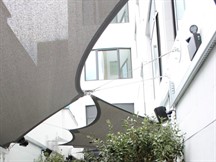Please note that TensileFabric is not a supplier of the fabrics detailed on this page.
Tensile fabric means fabric under tension and it is quite important to understand this.
Contrary to popular belief, we rarely use stretchy fabrics as they tend to be unpredictable – and as accuracy is so important we don't want to go down that route.
Once this is understood, further characteristics of the fabrics can be looked at; how it's going to be used, what it looks like, how wide it is, if it is waterproof and of course its fire rating – more on this later.
As well as using fabric specifically made for the Tensile Fabric industry, like PVC coated polyester and some Teflon fabrics, we do 'borrow' fabrics from other typical uses. Mesh fabric from the blinds industry is great for interior sun shading schemes – it is very low in stretch (so very predictable!) and carries a good fire rating.
Modern canvas fabrics typically used for boat biminis also provide a good fabric for smaller structures (where a more canvas look is required) but low stretch is still important.
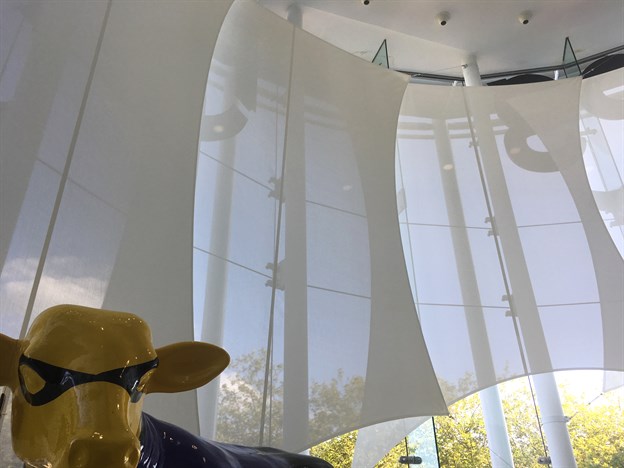
A mesh fabric is formed into sails and overlapped for interior shading in a sunny atrium space.
There are a number of factors that we look at to determine which fabric we will recommend for a particular project:
- Fire rating
- Colour range
- Sun shading qualities
- Waterproof ability
- Cost
- Visual qualities
- Width
- Joining method
- Blackout qualities
- Robustness
Fire rating
The required fire rating of a fabric will very often depend on where and how it is being used. Interior use, where large areas of fabric are forming a ceiling, will mean a certain rating is required, whereas a fabric that is vertically positioned in the same space may fall into a different required rating.
You should, therefore, check with your fire office which fire rating is required for the specific item you are designing/installing. Many fire officers are unclear when it comes to fabric - often just saying a 'Class O' – when in fact if further clarification is required, there may be options of what is appropriate to use. We find it is worth suggesting a few ratings to an officer – as they will often have a list of satisfactory ratings to use.
In the UK we are complying with the British Standard (BS) and from April 2007 we have also been using the Euro classification. The Euro classification was a new way of testing the fire rating of items, and in the fabric application it was more appropriate than the existing BS tests, taking into account surface spread of flame as well as smoke and droplets. Now we have left the EU we are no doubt going to divert back to the BS ratings – although as most of the fabrics we use come in from Europe – both ratings are best provided to allow transparency on the matter.

For this project at Gatwick Airport, a glass-based mesh fabric was combined with an acoustic foam layer in order to improve the acoustics within the walkway. Both these materials are the highest fire rating BS 476 part 6 and 7.
Colour range
Many of the fabrics we use are only produced in a white and customer preference has dictated that only white is wanted within the industry. This is particularly the case for heavier 'architectural' fabrics that would be typically used for large canopies. Where a colour is required for a canopy, a 'middle weight' material will often need to be used – though the range will rarely be huge – and changes on a year-by-year basis as colours go in and out of fashion.
Certain fabrics do come in a range of colours so that you can pick a colour to suit your scheme. Where this is not possible, or where graphics may be required, printing onto fabric is an option - using the latest UV ink for ink jet printing or dye sublimation for a strong permanent non-scratch printed onto woven textiles fabrics.
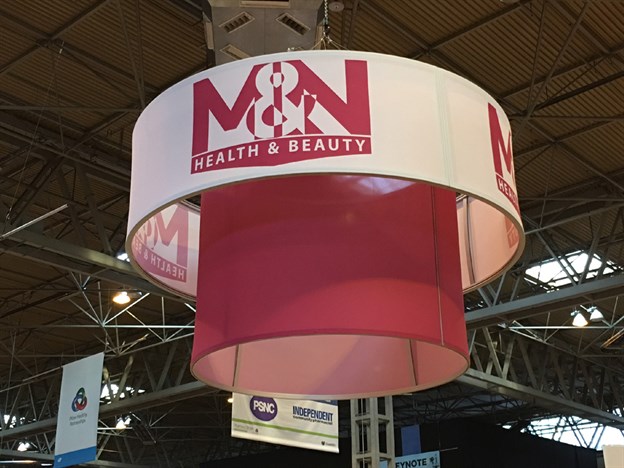
A coated polyester fabric is printed using the dye-sublimation process to get the exact colour match for this brand.
Sunshade
Tensile fabric can be used both internally and externally and therefore is ideal for shading against the sun whether you are inside or outside.
For outdoor use the sunshade will invariably also be waterproof as it then provides protection from all weathers. The amount of shade and UV block offered by a fabric depends on a number of things: its weight, its colour and its technical make up (as some fabrics are laminated with particular layers to prevent UV transmission).
Often specific details of a project's requirements will steer us towards recommending the use of a particular fabric.
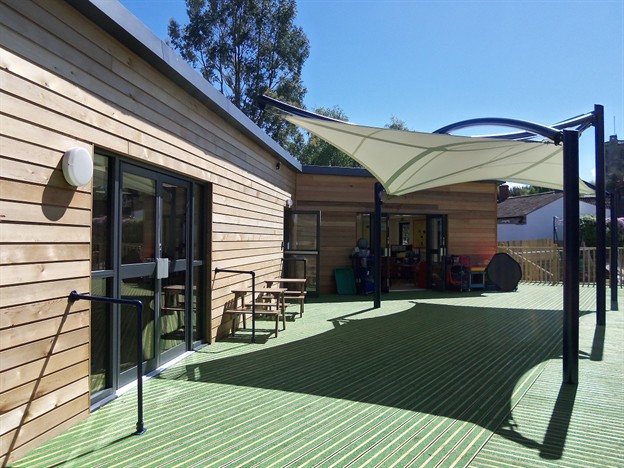
This playground canopy uses a classic white PVC-coated fabric for its excellent sun shading, waterproof qualities, life span and value.
For indoor use, sun shading is focused around protecting people from sunlight, glare and heat in heavily glassed areas such as atriums and receptions. For these spaces we recommend various types of mesh fabric (in different weights, colours and openness factors) which offer predictable light reflecting and diffusing qualities.

A 1% openness fabric is used here for this reception desk which was flooded with sunshine. This fabric protects staff from the glare and heat whilst still letting in the daylight.
Waterproof
For outside use we always suggest a waterproof fabric for maximum protection from the elements. We use PVC coated polyester, some nylon and some others – depending on what kind of look and feel is desired. We do use some canvas fabrics, but more often than not they are not suitable for permanent exterior canopies as they tend to stretch, fade and break down comparatively quickly, not offering great value.
For water control, we recommend adding fabric gutter upstands into the fabric as well as hoppers to collect the water as part of the tensioning detail. For this project (see below) at a school in Cambridge, we integrated the gutter details to tie in with their existing draining system.
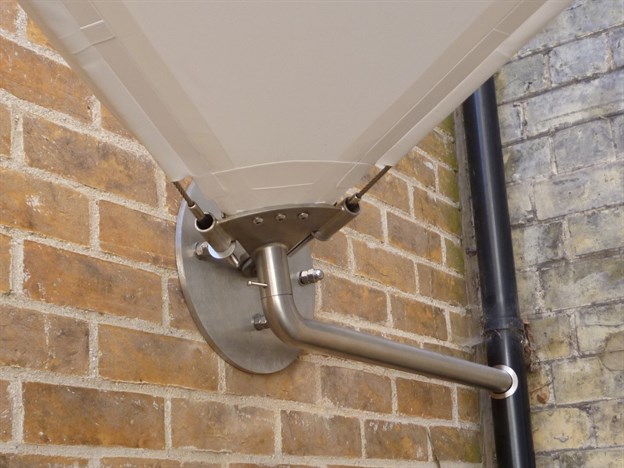
Here gutter details have been integrated for water drain-off.
Cost
Fabric costs vary hugely depending on a number of factors, including base cloth type, quality (European fabric is a lot more expensive than fabric from the Far East) and quantity (although this is not always relevant). We aim to offer a wide range of fabric choice to match our clients' briefs and budgets as much as possible.
Visual qualities
Last but not least, and perhaps the most subjective of considerations, is what the fabric looks like and what overall look is trying to be achieved. All fabrics have different visual qualities – texture, translucency, shininess, etc – and personal preference will play a big part in which fabric is ultimately chosen – but hopefully this guide will lead you down the correct avenue.
Sustainability and efficiency
For the actual process of recycling fabric, the options are quite limited unfortunately. Mixed fibre fabrics that are hard to separate, mean that industries rarely want them for remanufacture. Other fabrics that can be split back to their base materials are only processed in central Europe – thus transport costs currently mean that the offset of recycling is cancelled out by the pollution generated to take it there. The recycling capabilities however are always changing - and as focus shifts from 'as inexpensive as possible' to 'long lasting and still able to be recycled' we will strive to be very much part of this improvement.
As a business one thing we can do to be sustainable is to be as efficient as possible, using fabric and materials in the most efficient way possible. As part of our fabric manufacture process we nest our patterns on our fabric to make sure there is little to no wastage. We also take every opportunity to pass on any 'spare' materials from a project to local scrap stores and local schools to make sure the fabric is at least being fully utilised.
Our objective is that by achieving an efficient business, we simultaneously minimise our impact on the environment.
Fabric Samples

News
Sample Fabrics Table
| Fabric Type | Weight (g/Sqm) | Description | Application / Recommendations | Fire Rating | Colours | Printable |
|---|---|---|---|---|---|---|
| E Screen (3500) | 410 | Light weight PVC coated glass based mesh fabric (welded or stitched). | Internal structures, including ceilings and screens. | BS 476 Pt 6 & 7. Class O M1, B1 | Range Available | Yes |
| Natte 4503 | 470 | Medium weight PVC coated glass based mesh fabric (welded or stitched). | Internal structures, including ceilings and screens. | BS 476 Pt 6 & 7. Class O M1, B1 | Range Available | Yes |
| Satine 5500 | 535 | Heavy weight PVC coated glass based mesh fabric (welded or stitched). | Internal structures, including ceilings and screens. | BS 476 Pt 6 & 7. Class O M1, B1 | Range Available | Yes |
| FR Nylon | 250 | Lightweight nylon fabric (stitched only). | Internal ceilings, screens and 3-dimensional shapes. | BS 5867 | White plus others | No |
| FlagKnit Polyester | 115 | Very light weight polyester fabric mesh fabric - translucent (stitched only). | Internal screens/printed structures. | M1 & BS 5867 | White | Yes |
| Battyline | 560 | Heavy weight coated woven mesh fabric. | Internal ceiling, pool ceilings (moisture stable). | M1,B1 | Range Available | Yes |
| PVC (Ferrari 702) | 750 | Exterior canopies. PVC for Banners. Smooth appearance (welded/stitched). | Exterior Structures / Banners. Very good for printed structures. | Vary - M1/M2 depending on manufacturer | Range Available | Yes |
| Trevira (polyester) | 68 | Woven Polyester Fabric (stitched only). | Interior/Exhibition structures. Including printing. Excellent for back lighting. | BS 5867 pt.2 (BS5438 Test 2) | White | Yes |
| Insight | 222 | Acrylic Canvas material with a woven appearance (stitched only). | Interior/Exhibition structures. Including printing. | DIN 4102 , B1 | White | Yes |
| Light Weight Vision | Starched cotton fabric. Woven appearance (stitched only). | Interior/Exhibition structures. Including printing. | M1, B1 | White | Yes | |
| Standard Mesh | 230 | Medium weight coated woven mesh fabric (stitched or welded). | Interior/Exhibition structures/banners Including printing. | DIN 4102, B1 and M1 | White | Yes |
| Supreme Mesh | 330 | Medium weight moulded PVC coated Polyester Mesh (welded or stitched). | Interior/Exhibition structures/banners Including printing. | DIN 4102, B1, M1,BS/T19 | White | Yes |
| Acrylic Canvas | 340 | Tough Woven fabric for exterior use. Water resistant (stitched only). | Exterior Structures / Sails. | Not FR | Range Available | No |
| Firex | 266 | Woven Nylon fabric. Close weave (stitched only). | Interior Structures. Excellent for backlighting. | M1 | White only | No |
| Acoustis 50 | 410 | PVC coated glass fabric welded or stitched. | Acoustic fabric to reduce the reflection of sound waves in a room. Internal ceilings, screens and 3-dimensional shapes. | BS 476 Class 0 | Range of 12 | Yes |
| Flock Blockout | 350 | Textile. Light flexible blackout fabric. | Exhibition printed screens, signs and 3-dimensional shapes. | BS 5867 | White only | Yes |
| Soltis 86 | 380 | PVC coated polyester mesh fabric. | External blinds, Internal screens, Internal ceilings. | M1, B1, Euro class B-s2, d0 | White plus 22 colours | Yes |
| Soltis 92 | 420 | Low Openness factor PVC coated polyester mesh fabric. | External blinds, Internal screens, Internal ceilings. | M1, B1, Euro class B-s2, d0 | White plus 45 colours | Yes |
| HT Coated Polyester | 212 | Coated Polyester Solid Fabric. | Internal ceiling, sculpture - Excellent Dye Sublimation media. | BS5867 pt 2 - 1980. B1. M1 | White | Yes (3.1m wide) |
| Polyester Canvas | 250 | Polyester Canvas - with flexible bias weave. | Internal printing - Excellent Dye Sublimation media. | DIN 4102 - B1 | White | Yes (3.2m wide) |

 Looking for a stylish garden shade? View our custom-made canopies…
Looking for a stylish garden shade? View our custom-made canopies… Need something a bit out of the ordinary? Interior, exterior and exhibition projects that go beyond the norm…
Need something a bit out of the ordinary? Interior, exterior and exhibition projects that go beyond the norm… Seen our range of pre-designed exhibition products? Easy to specify, use and reuse…
Seen our range of pre-designed exhibition products? Easy to specify, use and reuse… Read about our acoustic products for great solutions to poor interior acoustics…
Read about our acoustic products for great solutions to poor interior acoustics… Need a permanent indoor fabric screen or ceiling? See our bespoke interior portfolio…
Need a permanent indoor fabric screen or ceiling? See our bespoke interior portfolio…
